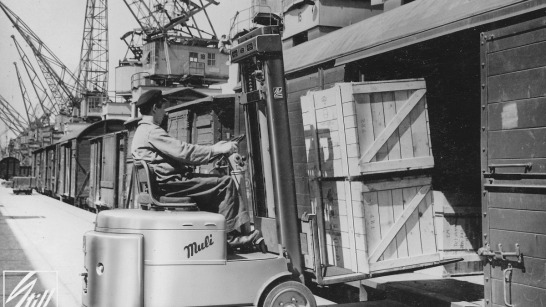Imitation Learning: The Key to Autonomy
One key aspect of developing driverless forklift trucks is the use of imitation learning. This method makes it possible to train the AI and mimic the behavior of an experienced driver. Recurring tasks performed by a forklift truck are particularly well suited to this learning method. “Repetitive operations such as load handling in intralogistics with industrial trucks are ideal for the imitation learning method,” says Mirko Schaper, Research Assistant at the Institute of Transport and Automation Technology at Leibniz University Hanover.
Another advantage of imitation learning is its efficiency in comparison to traditional programming methods: “A manual, deterministic programming solution for these driving tasks would have been so time-consuming as to be impracticable, and it would also have been inflexible in the face of changeable environmental conditions,” adds Schaper. Using data from the simulation, the AI learns to perform precise maneuvers and to move the truck efficiently through the warehouse—even in the event of imprecisely positioned load carriers or unexpected obstacles.
Flexibility for Brownfields: A New Goal for Automation
KION Group’s current automation solutions are successful but very limited in their application, particularly for clearly defined tasks in warehouses. “Our classic automation solutions have been available on the market for many years and are used in many different applications, especially in precisely defined warehouse processes with structured warehouse environments, which we refer to as ‘greenfields‘. However, we also want to address customers with existing warehouses and processes—known as ‘brownfields’—where people and automated trucks work together. To do this, we need more flexibility,” explains Dr. Lukas Hindemith.
The new AI-based technology is intended to close precisely this gap. By responding with greater flexibility to the structures and processes already in place in an existing warehouse, not only could it take on recurring transport tasks in structured warehouses, but it could also be used in established storage facilities. The goal is to enable seamless collaboration between human and machine.
The Next Step: From Virtual Forklifts to the Real Thing
While simulations offer a safe and controlled environment, the next milestone will be to apply these learnings in the real world, building on the progress made so far. This process will involve an experienced driver sitting in an FM-X reach truck specially converted by STILL for this project and fitted with sensors and cameras—the aim being
to train an AI using actual driving data. This step will build on the experiences and results from the simulation that preceded it. This transition from the digital to the real world will show how well AI can perform in overcoming real-world challenges and responding to unexpected situations.
The truck’s digital twin will continue to play a crucial role here. With the help of sensors and software applications, it records, analyzes, and visualizes data in real time, enabling the forklift truck’s behavior to be continually monitored. Real-time exchange of data enables any problems to be identified and resolved immediately. This combination of simulation and real-world use is a crucial step toward making the technology market-ready and boosting confidence in its operational capability.
A Look to the Future
After the development stage, there is one last crucial step before the driverless trucks can be rolled out for widespread use, and that is safety. “To begin with, the models that we are currently working on need to be made operational. The next step is to make them safe enough to be used in practical applications. The safety certificates required for this are on the way,” explains Dr. Johannes Hinckeldeyn, Global Research Manager at Global Technology Strategy at the KION Group.
The use of simulations and AI opens up a multitude of possibilities for optimizing processes in the future. Intelligent forklift trucks can collaborate with people and other autonomous systems, such as autonomous mobile robots (AMRs), creating a seamless, highly efficient warehouse ecosystem in the process. The continuous development of these technologies and their integration into existing systems promises a future, in which warehouse processes will organize and optimize themselves.
This vision will require creativity, ongoing development and close collaboration with partners and customers to develop solutions that meet the real needs of the industry. The focus in the coming years will now be on developing autonomous forklift trucks that can be used in real warehouse conditions.





/website-story-innovations-dematic-part-2_pic05_image_546x307.jpg)